Solid Waste Industry Starts Off Strong in 2021 (New Research)
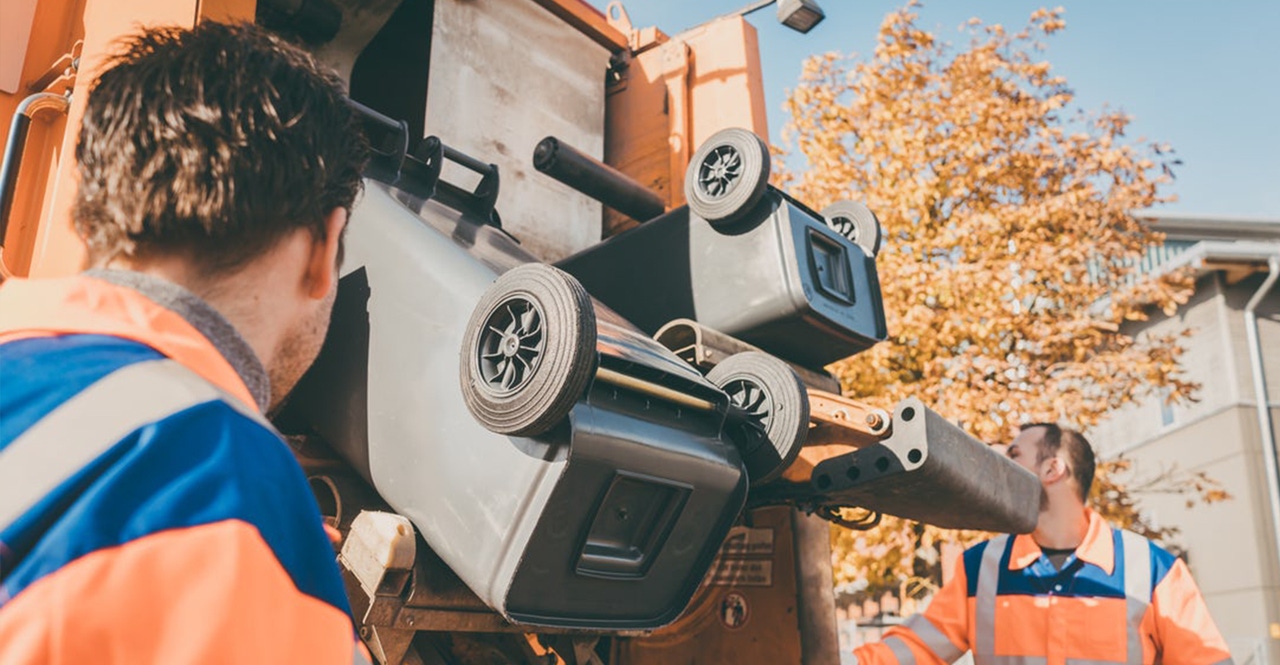
Stifel and Waste360 conducted a survey of solid waste service companies focused on post-pandemic trends exiting 2020. Michael E. Hoffman, managing director and group head of diversified industrials at Stifel stated that, “As many of you are aware, I have a very positive view about solid waste as a business and correspondingly as a core holding in investment portfolios. The industry and the public companies continue to demonstrate how durable the business is and how nimble the public companies proved to be during the pandemic.”
The survey results confirmed what has been widely discussed over the past year around residential vs. commercial volumes. Residential collection volumes across nearly 80% of respondents are up 14% while commercial collection volumes and customers are down across 62% of those surveyed with 15% of the customers on a service-on-hold or cancelation.
Here are some highlights from Stifel’s report that expands on the research:
There is a sustained work-from-home (WFH) impact on residential volume into 2021 but about one-third of the increase can be offset with price.
The recycling business model is well on its way to a move away from commodities and focused on production costs.
C&I service interval changes happened at the restart or are not needed for the majority of customers.
Capital spending trends are mostly unchanged and what cuts are happening are in rolling stock – trucks and containers.
Elections matter, at least this year as concerns about rising taxes and slowing economic growth surface.
M&A neither accelerating nor decelerating from a process generally driven by the Five-Ds: Descendants pushed into action by death, divorce, disability and disease.
2021 price and volume trends better than 2.5% price and more than 2% volume possible.
Some cost savings in 2020 are sustained leading to a better incremental margin in 2021.
Residential
Work-from-home (WFH) means that there is more cart/bag weight – or overall that the truck is coming off the route heavier for the same number of stops. Exiting 2020, nearly 80% of respondents have seen a sustained increase in weight of which only about one-third have been compensated for the added weight.

Commercial
In our Spring 2020 survey, the immediate impact of the pandemic was a service-on-hold (29%)/cancel (9%) rate of 38%. Exiting 2020, the respondents have 15% of customers on either a hold (10%) or canceled (5%). Only 15% sought a service interval decrease offset by 10% seeking an increase and two-thirds sought no change in service interval as of year-end. Container weight is down for two-thirds of respondents but nearly 15% have seen an increase.
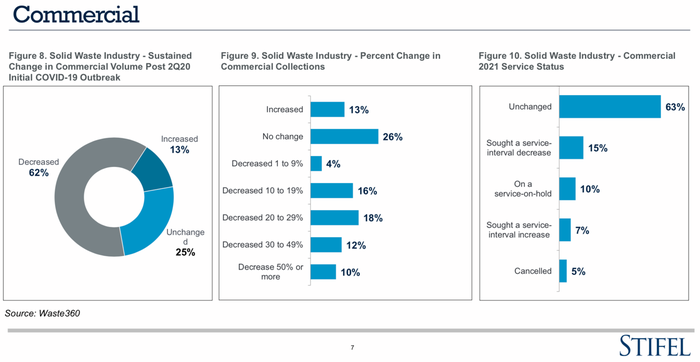
Permanent Roll-off
The spring 2020 survey had 29% of customers canceled (5%)/service-on-hold (24%). Exiting 2020, this trend is down to 17% with cancels at 6% and service-on-hold 11%. Exiting 2020 with more of the country reopened, volumes have increased (40%) or been unchanged (35%) for 75% of the respondents, The average change in volume is an increase of 4%.
Hoffman said, “This data was a pleasant surprise juxtaposed against mainstream media pushing the WFH theme as not changing to BTO (back-to-work). However, reviewing the vehicle miles traveled and rush hour data available in the second half of 2020, there was some level of back-to-work relative to the shutter-in-place impact on WFH. Some of this trend will support better volume trends in C&I in 4Q20 than originally forecast.”
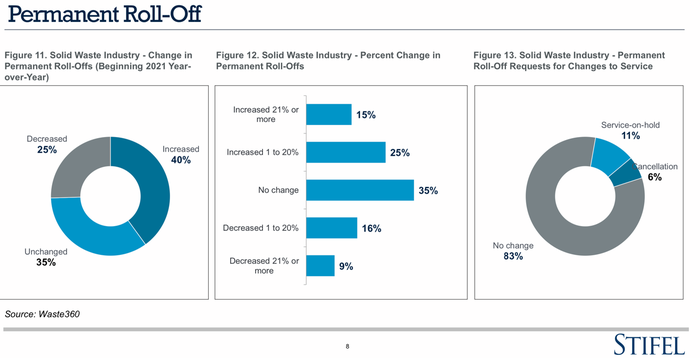
Temporary Roll-off
Shutter-in-place orders drove a reduction in roll-off pulls for two-thirds of respondents in the Spring 2020 survey. Exiting 2020, about 25% of respondents saw a year over year reduction in pulls with over one-third no change and nearly 40% a year over year increase. End markets serviced by the respondents split 45% non-residential, 33% residential and the remainder infrastructure.
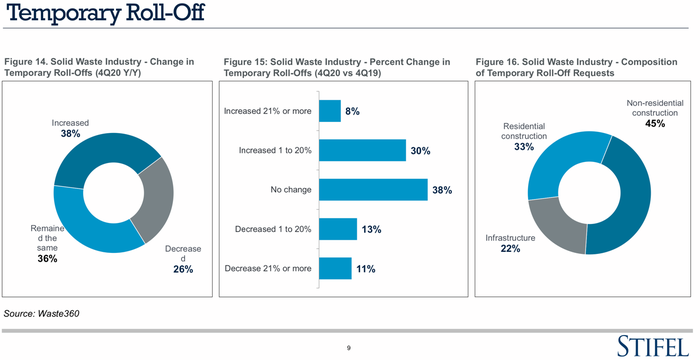
Recycling business mix
The survey results support that the market has been shifting to a process-fee from a dependence on commodity sale with the respondents nearly split evenly between fee (49%) vs. commodity (51%).
The commodity exposure has been reduced to less than 50% for 43% of the respondents with a commodity exposure. We suspect the public companies are in line with the survey trends but with a bias to 50%-55% converted to a fee structure with the split 60% at the MRF and 40%-50% recycling collection contracts converted.
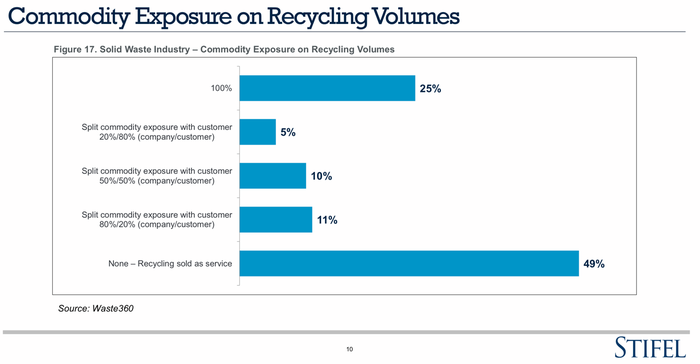
Do elections matter? This one seems to matter.
Economic outlook: Nearly 55% of respondents believe the election outcome will impact the economy with nearly 60% expecting the economy to be worse and approximately 30% see it better,
Taxes: Just under 60% of respondents believe business tax rates will rise on average at least 15%.
Capital Spending: One-third of respondents plan to spend less capital, around 15% will spend more, and the remainder has no plans to change spending in 2021.
2021 Trends
Price: Overwhelmingly all the respondents expect price to rise and 55% see an increase of 2.5% or more, with more than 20% looking for an increase greater than 4%.
Volume: Overall the respondents expect an average increase of 2.5% but 15% do anticipate negative volumes while nearly 4% think volumes could be up more than 4%.
The “Exiting 2020 and Looking into 2021 – Solid Waste Ended Well Starts off Strong” report goes into more details about the M&A outlook, capital spending and more. See the full report here.
About the Author
You May Also Like




.png?width=300&auto=webp&quality=80&disable=upscale)